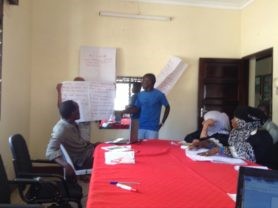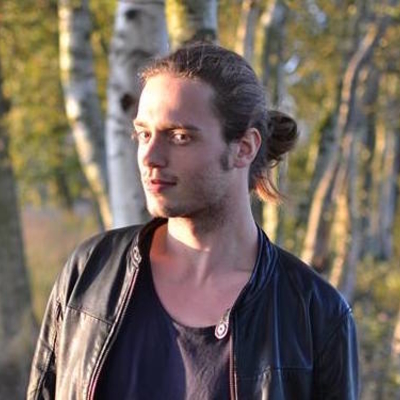In this post, I would like to introduce you to my research project on youth and interreligious co-existence in Coastal Kenya, as well as share how initial fieldwork experiences have so far shaped my thinking. My project started one and a half year ago, and at this moment I am taking a short break in between two fieldwork trips.
I started this project from an observation made in earlier research, that most research on religion, conflict and peace identifies youth mostly as either possible perpetrators and/or victims of conflict. It is also often assumed that especially marginalized or jobless youth are easily mobilized for conflict by religious arguments. Similar lines of reasoning can be found in Kenya, where frequent efforts are undertaken to counter the involvement of youth in conflicts or radical (religious) groups. While there often is at least some truth in these assumptions, they regularly cause scholars to neglect how youth maintain or build more peaceful interreligious relations, despite poverty and marginalization. Furthermore, these assumptions often cause scholars to overlook every-day (often peaceful) encounters between youth from various religious backgrounds. Based on these considerations, I wanted my project to provide more ethnographically informed notions on how youth perceive and shape interreligious relations, in a region in which peaceful interreligious co-existence is occasionally challenged.
My project focuses on the town Malindi, which is situated at Kenya’s coast, a region with significant presence of Islam, Christianity, and Mijikenda traditionalism. The region has a long history of both peaceful and more competitive interreligious encounters, and has recently also seen new challenges to peaceful co-existence. Mainly because of recent activity of terrorist organization Al-Shabaab along Kenya’s coast, several organizations are currently active in Malindi to improve interreligious relations, and they often involve youth in their peacebuilding efforts. In my research, I have taken three such organizations as a starting point, to which I will refer in this post as organizations (1), (2), and (3).
Organization (1) is a secular organization that provides civic education. The organization is funded by the British High Commission to ‘build resilience against violent extremism’ and aims to do so by (a) organizing interreligious dialogues, and (b) providing youth and women with entrepreneurship trainings. Organization (2) is an umbrella organization for Muslim leaders that also gets funds from the British High Commission. Organization (2) uses these funds to (a) provide peace education to students in schools and madrassa’s and to (b) organize interreligious dialogues. Organization (3) brings clerics from various religions along Kenya’s coast together. This organization unites Muslim, Christian and traditional leaders to address shared challenges and improve relations between them. Specifically, the religious leaders involve themselves in (a) interfaith dialogues for peace, and (b) programs to counter early marriages and sexual abuse of children and youth. While these organizations differ from each other in many aspects, it is interesting that all aim to improve interreligious relations, and involve youth in their work to attain this goal. Through a focus on these organizations and also taking into account every-day interreligious encounters, I aim to improve my understanding of how youth from various religious backgrounds perceive, influence and/or actively shape modes of interreligious co-existence, in various institutional and social settings within Malindi.
Although my focus on these civil society organizations (CSOs) was partly informed by pragmatic considerations on how to access the field, I also have theoretical reasons to operationalize my research through a focus on CSOs. This is because Western development policies that aim to mediate interreligious and interethnic tensions in African countries often focus on strengthening civil societies in order to build a strong foundation for peaceful secular democracies. From this perspective, interreligious and interethnic tensions in Africa are understood in terms of the failure of secular institutions, forms of organization, and political rationality to gain influence.
Instead of seeing the continuing presence or even revival of religion in African societies as fundamentally incompatible with secularism, I follow the recent work of Saba Mahmood who acknowledges the possibility that projects of political secularism can gain influence alongside (the public presence of) religious practices, values, beliefs and aesthetics.1 Political secularism indeed only rarely involves the (complete) absence of religion from politics or public life, but can be more adequately described as a project that forwards promises of religious liberty and minority rights that are to be guaranteed through state neutrality towards religions. But these promises are however also symptomatic of the limits of political secularism, as it never fully achieves its claims to make religion indifferent to identity constructions or the distribution of rights and freedoms. Therefore, Mahmood argues that political secularism should not be understood as resting on a priori distinctions between religion and politics or the public and private domain, but as a project that continuously (re)creates and (re)negotiates these distinctions. Through this process, the role of religion in society is continuously (re)defined and regulated.
These theoretical perspectives raise fruitful questions about the CSOs that I follow in my research. On the one hand, these organizations are funded by secular European countries and operate within the Kenyan secular state. On the other hand, all organizations, whether religious or not, strongly focus on religious actors to build peaceful interreligious relations and/or counter youth radicalization. Therefore, I look at the organizations that I follow as places where various religious and secular actors, practices, values and ideas meet, and are translated and negotiated, while raising critical questions on how the complex entanglements that result from these negotiations influence modes of interreligious co-existence. Of course I am particularly interested in the roles that youth play in these constellations, given that they are seen as actors that are easily mobilized to join radical groups or participate in (religious) conflicts.
When I initially arrived in Malindi and started following two of the organizations that I have introduced above, I was struck by the fact that almost all my interlocutors insisted that Malindi is a very peaceful place and that there are no conflicts along religious lines. Instead, most people seemed to be much more concerned with all sorts of problems that youth are involved in, that might corrupt their roles as upright (religious) community members and/or Kenyan citizens. These challenges include drug-abuse, engaging in immoral love or sexual relations, the possibility that youth are mobilized for conflict along ethnic or religious lines by politicians, the (potential) recruitment of youth into radical groups, and the killing of elders after witchcraft accusations. In various cases, even youth themselves would confirm these negative stereotypes that are often repeated in and outside CSOs in Malindi.
At a first glance, these observations seem to confirm the scholarly theories that I found to be too limited when I started my research project, that often see youth as possible perpetrators to violent conflict. However, during one particular fieldwork moment I realised that such a conclusion would be too short-sighted nevertheless. During a USA-funded anti-radicalization training given to youth by an Islamic civil society organization, a few youth cautiously raised some of the challenges they encounter as young Muslims within Malindi, which included continued harassment by security agents as well as difficulties obtaining an official ID, which you need to cast your vote during elections. During the training however, the facilitator insisted that it would be wrong to address such challenges within a mosque, as mosques are places where you are supposed to pray and recite the Qur’an, implying that mosques should not be used as a platform to discuss political issues. The facilitator subsequently strongly suggested that mosques that have been closed by the government in the past on accusations of spreading violent extremism have been rightfully closed, as political issues were most probably raised within those mosques, which is dangerous because this can lead to interreligious conflicts. This observation resonates with countless other experiences that I had in Malindi, in which youth are discouraged to make political claims that refer to religion or ethnicity, while an overarching Kenyan identity is emphasized instead.
These observations made me aware of the ways in which what could be seen as secular attitudes, namely (1) making a clear separation between religion and politics and (2) discouraging youth to make political claims along religious or ethnic lines, might perhaps unintentionally also function as a way to limit the possibilities that youth have to address legitimate issues that affect their lives. This line of reasoning may also partly explain why youth sometimes tend to confirm negative stereotypes about them, as their political space is generally rather limited. At the same time, the fear that youth go astray in various ways can and often does provide more powerful actors, such as politicians, religious leaders and CSOs, with incentives to give youth support and opportunities, such as the youth entrepreneurship trainings that are given by organization (1), that are aimed to counter radicalization. It is to this complex role that youth play in negotiations about peaceful interreligious co-existence that I want to devote more attention as my project continues.

References
(1) Saba Mahmood, Religious Difference in a Secular Age: A Minority Report (Princeton 2016). Click here.


